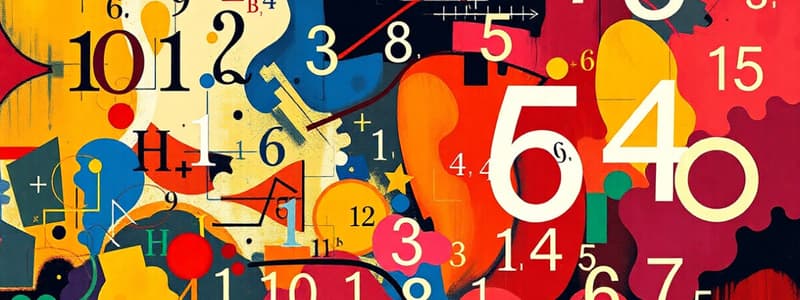Podcast
Questions and Answers
What type of numbers do natural numbers include?
What type of numbers do natural numbers include?
- Whole numbers only
- Negative numbers and zero
- Rational and irrational numbers
- Counting numbers only (correct)
Which of the following mathematical fields studies shapes and sizes?
Which of the following mathematical fields studies shapes and sizes?
- Geometry (correct)
- Statistics
- Arithmetic
- Algebra
In which of the following number systems would you categorize the number $-2.5$?
In which of the following number systems would you categorize the number $-2.5$?
- Natural numbers
- Rational numbers (correct)
- Irrational numbers
- Integers
Which concept is NOT typically studied in calculus?
Which concept is NOT typically studied in calculus?
What distinguishes complex numbers from real numbers?
What distinguishes complex numbers from real numbers?
Flashcards
Arithmetic
Arithmetic
The branch of mathematics that deals with numbers, their properties, and operations on them, including addition, subtraction, multiplication, and division.
Algebra
Algebra
A branch of mathematics that uses symbols and letters to represent unknown quantities and relationships.
Geometry
Geometry
The branch of mathematics that studies shapes, sizes, positions, and properties of two-dimensional and three-dimensional objects.
Trigonometry
Trigonometry
Signup and view all the flashcards
What are rational numbers?
What are rational numbers?
Signup and view all the flashcards
Study Notes
Fundamental Concepts
- Arithmetic is the foundation of mathematics, involving basic operations like addition, subtraction, multiplication, and division.
- Algebra extends arithmetic by introducing variables and equations to represent unknown quantities.
- Geometry deals with shapes, sizes, and positions of objects in space.
- Trigonometry connects angles and sides of right-angled triangles.
- Calculus involves concepts like limits, derivatives, and integrals for analyzing change and motion.
- Statistics and probability use data analysis to determine likelihoods of events or outcomes.
- Discrete mathematics studies mathematical structures that are not continuous.
Number Systems
- Natural numbers: Counting numbers (e.g., 1, 2, 3).
- Integers: Whole numbers and their opposites (e.g., -3, -2, -1, 0, 1, 2, 3).
- Rational numbers: Numbers that can be expressed as a fraction p/q, where p and q are integers and q is not zero (e.g., 1/2, 3/4, -2/5).
- Irrational numbers: Numbers that cannot be expressed as a fraction (e.g., π, √2).
- Real numbers: The set of all rational and irrational numbers.
- Complex numbers: Numbers that contain an imaginary part (often denoted with 'i' for the square root of -1).
Algebra
- Variables represent unknown quantities.
- Equations state equality between expressions.
- Inequalities show relationships between expressions using symbols like >, <, ≥, ≤.
- Polynomials are expressions involving variables and coefficients often expressed as sums.
- Factoring involves breaking down a polynomial into simpler expressions that when multiplied together, give the original polynomial.
- Solving equations involves finding the value(s) of the variable(s) that make the equation true.
- Functions relate dependent and independent variables.
Geometry
- Points represent locations.
- Lines are straight paths connecting points.
- Angles are formed by two intersecting lines.
- Triangles are three-sided polygons.
- Polygons are shapes with straight sides.
- Circles are shapes with every point equidistant from a central point.
- Solids have three dimensions (e.g., cubes, spheres).
- Geometric transformations involve moving, resizing, or reflecting shapes.
Trigonometry
- Deals primarily with relationships in right-angled triangles.
- Trigonometric ratios (sine, cosine, tangent) relate angles and sides.
- Applications in engineering and navigation are significant.
- Trigonometric identities are equations to express trigonometric functions in altered forms.
Calculus
- Differential calculus focuses on instantaneous rates of change.
- Integral calculus deals with accumulation of quantities over intervals.
- Applications are extensive in physics, engineering, and economics for modeling motion, areas, volumes, and more.
- Limits are essential concepts in calculus describing what happens as something approaches a certain value.
Statistics and Probability
- Statistics involves collecting, organizing, analyzing, and interpreting data.
- Descriptive statistics summarizes data, using measures such as mean, median, and mode.
- Inferential statistics uses sample data to draw conclusions about a larger population.
- Probability measures the likelihood of an event occurring.
- Outcomes and sample spaces are crucial elements in probability calculations.
Discrete Mathematics
- Focuses on countable or discrete objects, not continuous ones.
- Includes topics like graph theory, logic, and combinatorics.
- Application areas include computer science, operations research, and networks.
Problem Solving Strategies
- Understanding the problem statement.
- Identifying relevant facts and concepts.
- Developing a plan to solve the problem.
- Implementing the plan to obtain a solution method.
- Evaluating the result to see if it makes sense and is reasonable.
Studying That Suits You
Use AI to generate personalized quizzes and flashcards to suit your learning preferences.
Description
This quiz covers essential mathematical concepts including arithmetic, algebra, geometry, trigonometry, calculus, statistics, and discrete mathematics. Test your understanding of various number systems and their applications in problem-solving.



